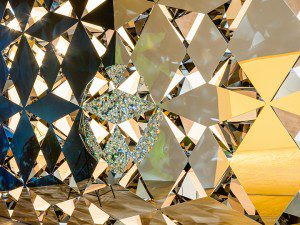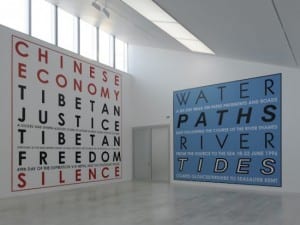My trip to see the contemporary art offerings of Manchester International Festival began Friday 5 July at Arndale Shopping Centre. This is Europe’s third largest mall, officially described as ‘the jewel in the city’s retail crown’. Wearing its consumerist status on its sleeve, and housing chain stores shouting prices from their windows, it goes without saying that Arndale is an unconventional setting for the work of art, which tends to keep its sales price hidden.
Nonetheless, on Hans Ulrich Obrist’s invitation to join the curatorial project ‘do it’ (an expansive series of instructions written by artists for open interpretation), Chicago based Theaster Gates proposed ‘HOW TO CATCH THE HOLY GHOST or GET ARRESTED IN A SHOPPING MALL’. According to Gates, catching the ghost/being caught requires ‘an adventurous buddy’ and the following props:
2 pairs of white gloves
2 old church hymnals
1 handkerchief
1 portable battery-operated amplification system
3 rocks (found on the street on your way to the mall)
White-gloves on, performers Alistair McNicol and Kamella Sophie-Lorelle followed instructions to create a ‘sacred space’. With Kamella sat, yogi-like, hymnals, handkerchief and rocks laid out before her, Alistair stood to sing lyrics selected from the books. For thirty minutes, of which I caught the last ten, he repeated the words ‘with souls refresh’, pacing back and forth between rails of a bridge linking Sole Trader and the Disney Store on one side with BOSE and Waterstones on the other. Sometimes slipping up to give ‘with shoals refresh’ / ‘with souls we fresh’, it was more interesting to watch the faces of shoppers – mostly pensioners or mothers with babies – betraying a kind of bored curiosity, than it was to wonder whether the Ghost had been caught. Obviously, this being an official part of the festival, no arrests were made. I wonder whether security would have been called had ‘HOW TO CATCH THE HOLY GHOST…’ been played out elsewhere, without forewarning. On this occasion, shoppers readily adopted roles as witnesses; whipping their camera phones out to film the uncommon event. It all ended abruptly: when thirty minutes were up the performers walked away and were lost from sight as they passed the Apple store, rocks and other props in hand.
More rocks could be found amongst the further five rooms of ‘do its’ exhibited in Manchester Art Gallery. In the ‘Homage Room’, devoted to the instructions of twenty artists deceased since the ‘do it’ project began, we find a rock magnetically attached to the wall, illustrating Olafur Eliasson’s instruction in homage to Francisco J. Varela. We are invited to take the rock in hand and, ‘While holding the meteorite, try to see yourself from the perspective of the orbiting asteroid belt. Think of this as your multiverse point-of-view’. An already difficult task is made harder by the presence of a mirror, installed immediately above the rock. On the same wall, those acquainted with the late Július Koller’s work will find the ‘asteroid viewpoint’ condoned again: the Slovak artist wrote of the potential formulation of a cosmological ‘subjective-objectivity system’. In this exhibition, however, Mladen Stilinovitć, assuming the role of Koller, has documented the task of sticking question marks to public poster texts considered in need of interrogation. The question mark was Koller’s chosen symbol, applied to public spaces such as tennis courts, to clothing, flags…, to convey the principle of questioning everything during the extended period of repression that followed the 1968 Prague Spring.
The performative, participatory nature of ‘do it’ was yet more evident in the ‘Active Room’, containing what HUO referred to as ‘many do its within the do its’ – opportunities for participation in e.g. squeezing lemons (Andreas Slominski), climbing ladders (Ilya Kabakov), or helping oneself to curry paste made by a volunteer following Rikrit Tiravanija’s recipe. If the ‘TV room’ was more passive, it compensated through self-conscious attempts at inclusivity: shorts by the highly reputed, e.g. Agnes Varda exploring the late Chris Marker’s studio, are found alongside works by recent Manchester School of Art graduates.
Danny Orwin, present for the screening of his film interpretation of Raqs Media Collective’s ‘do it’ (set in a library, it ends with the maxim ‘infect knowledge with wisdom’), said that Manchester felt like a good place to be post-graduation. As the festival began, I found this easy to believe – the MIF programme extends to the Whitworth Art Gallery for Nikhil Chopra’s ‘Coal on Cotton’, and to venues across the city for music and theatre events. Hopefully the energy generated during the festival will be sustained when it ends.
Lizzie Homersham
Manchester International Festival, 4 until 21 July www.mif.co.uk
Images courtesy Joel Fildes




